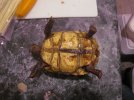Didn't get many responses in another forum so I'll try here :T
Basic care info and such-
5" carapace
About 2 years old
Diet: mostly mixed greens (spring mix, collards, kale, mustard, weeds in the right time of year) some veggies and some mazuri twice a week. Greens are dusted with calcium
40 gallon vivarium with layered bioactive substrate (soil/coir mix with cypress mulch on top)
Misted twice a day, humidity usually around 70
Temp range from mid 70's to high 80's
I also use a low level UVB fluorescent light
I've been having this issue with my red-foot's plastron. The very top layer just gets... peely and yuck looking. It's not soft and I don't see any white spots at least. But it isn't all shiny and 'waxy' looking like I tend to see.
The tank has plenty of dry spots and hiding places, yet she always digs down into the moist layer of the soil. (There's a drainage layer so it's not soaking, but it is damp) But, if I take away the soil entirely I have an extremely difficult time keeping the humidity up at all. :\ Adding a thicker layer of mulch doesn't help, she just digs through it.
And does the top of her shell look okay? I wasn't sure if it was as smooth as it could be.
Thanks!
Basic care info and such-
5" carapace
About 2 years old
Diet: mostly mixed greens (spring mix, collards, kale, mustard, weeds in the right time of year) some veggies and some mazuri twice a week. Greens are dusted with calcium
40 gallon vivarium with layered bioactive substrate (soil/coir mix with cypress mulch on top)
Misted twice a day, humidity usually around 70
Temp range from mid 70's to high 80's
I also use a low level UVB fluorescent light
I've been having this issue with my red-foot's plastron. The very top layer just gets... peely and yuck looking. It's not soft and I don't see any white spots at least. But it isn't all shiny and 'waxy' looking like I tend to see.
The tank has plenty of dry spots and hiding places, yet she always digs down into the moist layer of the soil. (There's a drainage layer so it's not soaking, but it is damp) But, if I take away the soil entirely I have an extremely difficult time keeping the humidity up at all. :\ Adding a thicker layer of mulch doesn't help, she just digs through it.
And does the top of her shell look okay? I wasn't sure if it was as smooth as it could be.
Thanks!


